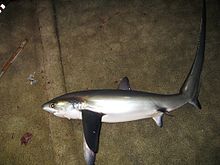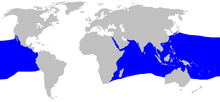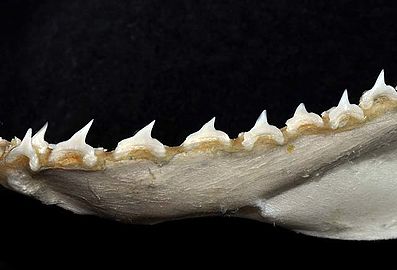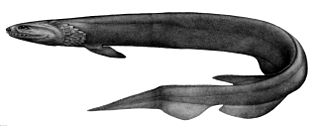
The frilled shark, also known as the lizard shark, is one of the two extant species of shark in the family Chlamydoselachidae. The frilled shark is considered a living fossil, because of its primitive, anguilliform (eel-like) physical traits, such as a dark-brown color, amphistyly, and a 2.0 m (6.6 ft)–long body, which has dorsal, pelvic, and anal fins located towards the tail. The common name, frilled shark, derives from the fringed appearance of the six pairs of gill slits at the shark's throat.

The Lamniformes are an order of sharks commonly known as mackerel sharks. It includes some of the most familiar species of sharks, such as the great white as well as less familiar ones, such as the goblin shark and megamouth shark.
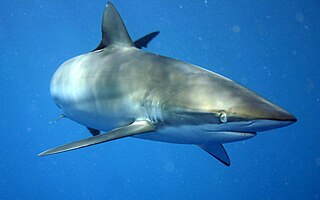
The silky shark, also known by numerous names such as blackspot shark, gray whaler shark, olive shark, ridgeback shark, sickle shark, sickle-shaped shark and sickle silk shark, is a species of requiem shark, in the family Carcharhinidae, named for the smooth texture of its skin. It is one of the most abundant sharks in the pelagic zone, and can be found around the world in tropical waters. Highly mobile and migratory, this shark is most often found over the edge of the continental shelf down to 50 m (164 ft). The silky shark has a slender, streamlined body and typically grows to a length of 2.5 m. It can be distinguished from other large requiem sharks by its relatively small first dorsal fin with a curving rear margin, its tiny second dorsal fin with a long free rear tip, and its long, sickle-shaped pectoral fins. It is a deep, metallic bronze-gray above and white below.
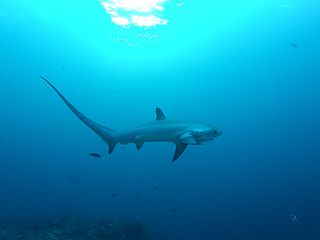
Thresher sharks are large mackerel sharks of the family Alopiidae found in all temperate and tropical oceans of the world; the family contains three extant species, all within the genus Alopias.

The cookiecutter shark, also called the cigar shark, is a species of small squaliform shark in the family Dalatiidae. This shark lives in warm, oceanic waters worldwide, particularly near islands, and has been recorded as deep as 3.7 km (2.3 mi). It migrates vertically up to 3 km (1.9 mi) every day, approaching the surface at dusk and descending with the dawn. Reaching only 42–56 cm (16.5–22 in) in length, the cookiecutter shark has a long, cylindrical body with a short, blunt snout, large eyes, two tiny spineless dorsal fins, and a large caudal fin. It is dark brown, with light-emitting photophores covering its underside except for a dark "collar" around its throat and gill slits.

The bigeye thresher is a species of thresher shark, family Alopiidae, found in temperate and tropical oceans worldwide. Like the other thresher sharks, nearly half its total length consists of the elongated upper lobe of the tail fin. Its common name comes from its enormous eyes, which are placed in keyhole-shaped sockets that allow them to be rotated upward. This species can also be distinguished by a pair of deep grooves on the top of its head, from which its scientific name is derived.

The silvertip shark is a large species of requiem shark, in the family Carcharhinidae, with a fragmented distribution throughout the tropical Indian and Pacific Oceans. It is often encountered around offshore islands and coral reefs, and has been known to dive to a depth of 800 m (2,600 ft). The silvertip shark resembles a larger and bulkier grey reef shark, but can be easily identified by the prominent white margins on its fins. It attains a maximum length of 3 m (10 ft).

The common thresher, also known as Atlantic thresher, is the largest species of thresher shark, family Alopiidae, reaching some 6 m (20 ft) in length. About half of its length consists of the elongated upper lobe of its caudal fin. With a streamlined body, short pointed snout, and modestly sized eyes, the common thresher resembles the pelagic thresher. It can be distinguished from the latter species by the white of its belly extending in a band over the bases of its pectoral fins. The common thresher is distributed worldwide in tropical and temperate waters, though it prefers cooler temperatures. It can be found both close to shore and in the open ocean, from the surface to a depth of 550 m (1,800 ft). It is seasonally migratory and spends summers at lower latitudes.
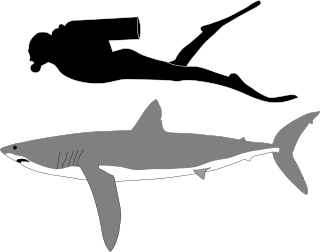
The longfin mako shark is a species of mackerel shark in the family Lamnidae, with a probable worldwide distribution in temperate and tropical waters. An uncommon species, it is typically lumped together under the name "mako" with its better-known relative, the shortfin mako shark. The longfin mako is a pelagic species found in moderately deep water, having been reported to a depth of 220 m (720 ft). Growing to a maximum length of 4.3 m (14 ft), the slimmer build and long, broad pectoral fins of this shark suggest that it is a slower and less active swimmer than the shortfin mako.

King-of-the-salmon, is a species of ribbonfish in the family Trachipteridae. Its common name comes from the legends of the Makah people west of the Strait of Juan de Fuca, which hold that this fish leads the salmon annually to their spawning grounds. Catching or eating king-of-the-salmon was forbidden, as it was feared killing one would stop the salmon run. This myth is reflected by a former specific epithet used for this fish, rex-salmonorum, rex being Latin for "king". The king-of-the-salmon is found in the eastern Pacific Ocean from Alaska to Chile. It is usually found in the open ocean to a depth of 900 meters, though adults sometimes feed on the sea bottom.

Oophagy or ovophagy, literally "egg eating", is the practice of embryos feeding on eggs produced by the ovary while still inside the mother's uterus. The word oophagy is formed from the classical Greek ᾠόν and classical Greek φᾱγεῖν. In contrast, adelphophagy is the cannibalism of a multi-celled embryo.

The crocodile shark is a species of mackerel shark and the only extant member of the family Pseudocarchariidae. A specialized inhabitant of the mesopelagic zone, the crocodile shark can be found worldwide in tropical waters from the surface to a depth of 590 m (1,940 ft). It performs a diel vertical migration, staying below a depth of 200 m (660 ft) during the day and ascending into shallower water at night to feed. Typically measuring only 1 m (3.3 ft) in length, the crocodile shark is the smallest living mackerel shark. It can be distinguished by its elongated cigar-shaped body, extremely large eyes, and relatively small fins.

The bigeye sand tiger is an extremely rare species of mackerel shark in the family Odontaspididae, with a possible worldwide distribution. A large, bulky species reaching at least 3.6 m (12 ft) in length, the bigeye sand tiger has a long bulbous snout, large orange eyes without nictitating membranes, and a capacious mouth with the narrow teeth prominently exposed. It can be distinguished from the similar smalltooth sand tiger by its teeth, which have only one lateral cusplet on each side, and by its uniformly dark brown color.

The night shark is a species of requiem shark, in the family Carcharhinidae, found in the temperate and tropical waters of the Atlantic Ocean. An inhabitant of the outer continental shelf and upper continental slope, this shark most commonly occurs at depths of 50–600 m (160–1,970 ft) and conducts a diel vertical migration, spending the day in deeper water and moving into shallower waters at night. Off northeastern Brazil, large numbers congregate around seamounts of varying depths. A slender, streamlined species, the night shark typically reaches a length of 2 m (6.6 ft). It can be identified by its long, pointed snout and large, green eyes, and is dark grayish blue or brown above and white below.

The viper dogfish or viper shark is a rare species of dogfish shark in the family Etmopteridae, and the only extant member of its genus. It has been found in the Pacific Ocean off southern Japan, the Bonin Islands, Pacific Ocean off northern Taitung County and the Northwestern Hawaiian Islands. This species inhabits upper continental slopes and seamounts. It may migrate vertically, shifting between bottom waters 270–360 m (890–1,180 ft) deep during the day and upper waters less than 150 m (490 ft) deep at night. A slender, black shark reaching 54 cm (21 in) in length, the viper dogfish can be recognized by its narrow, triangular jaws and well-spaced, fang-like teeth. It also has two spined dorsal fins, dermal denticles with faceted crowns, and numerous light-emitting photophores concentrated on its ventral surface.

The blurred lanternshark is a little-known species of dogfish shark in the family Etmopteridae, found around the world in benthic and pelagic habitats from a depth of 110 m (360 ft) to over 1 km (0.62 mi) down. This shark forms the E. pusillus species group with the smooth lanternshark, which are distinguished from other members of its family by having irregularly arranged, flat-topped dermal denticles that give them a "smooth" appearance. Both species are slender-bodied with long heads, two dorsal fins bearing spines, no anal fins, and light-emitting photophores. The blurred lanternshark is larger, reaching 67 cm (26 in) or more in length. This species feeds on small squid, fishes, and fish eggs, and is ovoviviparous. It has been assessed as of Least Concern by the International Union for Conservation of Nature, because of its wide distribution and lack of threat from fishing pressure.

The cloudy catshark is a common species of catshark, belonging to the family Scyliorhinidae. It is a bottom-dweller that inhabits rocky reefs in the northwestern Pacific Ocean, from the shore to a depth of 320 m (1,050 ft). Growing up to 50 cm (20 in) long, this small, slim shark has a narrow head with a short blunt snout, no grooves between the nostrils and mouth, and furrows on the lower but not the upper jaw. It is also characterized by extremely rough skin and coloration consisting of a series of dark brown saddles along its back and tail, along with various darker and lighter spots in larger individuals.

The Pacific angelshark is a species of angelshark, family Squatinidae, found in the eastern Pacific Ocean from Alaska to the Gulf of California, and from Ecuador to Chile, although those in the Gulf of California and southeastern Pacific may in fact be separate species. The Pacific angelshark inhabits shallow, coastal waters on sandy flats, usually near rocky reefs, kelp forests, or other underwater features. This species resembles other angel sharks in appearance, with a flattened body and greatly enlarged pectoral and pelvic fins. Characteristic features of this shark include a pair of cone-shaped barbels on its snout, angular pectoral fins, and a brown or gray dorsal coloration with many small dark markings. It attains a maximum length of 1.5 m (4.9 ft).

The pelagic stingray is a species of stingray in the family Dasyatidae, and the sole member of its genus. It is characterized by the wedge-like shape of its pectoral fin disc, which is much wider than long, as well as by the pointed teeth in both sexes, whip-like tail with extremely long tail spine, and uniform violet to blue-green coloration. It generally reaches 59 cm (23 in) in width. The pelagic stingray has a worldwide distribution in waters warmer than 19 °C (66 °F), and migrates seasonally to spend the summer closer to the continental shelf and at higher latitudes. The only stingray that almost exclusively inhabits the open ocean, this species is typically found in surface waters down to a depth of 100 m (330 ft). As a consequence of its midwater habits, its swimming style has evolved to feature more of a flapping motion of the pectoral fins, as opposed to the disc margin undulations used by other, bottom-dwelling stingrays.

Taractichthys steindachneri, the sickle pomfret, is a species of marine ray-finned fish, a pomfret of the family Bramidae. It is found in the Indian and Pacific Oceans.
